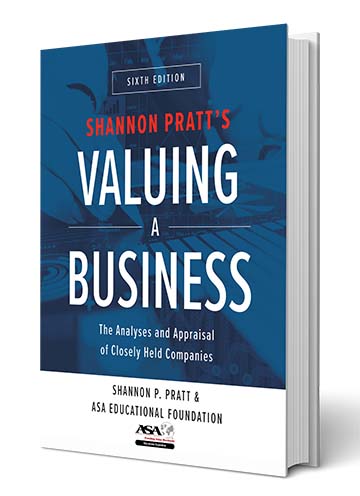Valuing a Business, 6th Edition
April 2022 Hardcover
Shannon Pratt
McGraw-Hill Co.
Since the first edition was published in 1981, the profession of business appraisal has matured immensely. The IRS has come out with business valuation guidelines, and the AICPA has published their business valuation standards. While each organization’s standards or guidelines are slightly different from the others, there is unanimous agreement on the central concepts of business valuation.
The seminal book on business valuation is back and better than ever. Shannon Pratt wrote and published the groundbreaking first edition of Valuing a Business in 1981. The 6th edition is written for business appraisers and users of business appraisal reports by some of the most accomplished appraisers in the profession in honor of Dr. Pratt and with his input and blessing. The 6th edition provides a comprehensive reference and update for business appraisers, a complete self-contained text for both academic courses and beginning practitioners, and an easy-to-use reference for non-appraisers who use and/or evaluate business appraisals.
Table of Contents
PART I State of the Profession, the Engagement, and the Basic Theory
1. Business Valuation Standards and Credentials
2. Defining the Assignment
3. Business Valuation Theory and Principles
Part II Gathering and Analyzing Data
4. Gathering Company Data
5. Site Visits and Interviews
6. Researching Economic and Industry Information
7. Analyzing Financial Statements
8. Financial Statement Ratio Analysis
PART III Business Valuation Approaches and Methods
9. Income Approach: Discounted Economic Income Method
10. Income Approach: Capitalized Economic Income Method
11. Income Approach: Developing the Discount Rate
12. Income Approach: Forecasting Economic Income
13. Market Approach: Guideline Public Company Method
14. Market Approach: Guideline Transaction Method
15. Asset-Based Approach: The Capitalized Excess Earnings Method
16. Asset-Based Approach: Asset Accumulation Method
PART IV Discounts, Premiums, and the Value Conclusion
17. Control versus Lack of Control: Premiums and Discounts
18. Market Evidence of Control Premiums and Discounts for Lack of Control
19. Discounts for Illiquidity and Lack of Marketability
20. Other Valuation Discounts
21. Valuation Reconciliation and Conclusion
PART V Writing and Reviewing Business Valuation Reports
22. Writing the Business Valuation Report
23. Sample Report
24. Reviewing a Business Valuation Report
25. Valuing Intangible Assets
PART VI Valuing Specific Securities and Interests
26. Valuing Debt Securities
27. Valuing Preferred Securities
28. Introduction to Stock Option Theory
29. Valuing Employee Stock Options
30. Valuing Complex Capital Structures
31. Valuing Interests in S Corporations Other Pass-Through Entities
32. Valuing Interests in REITs and other Real Property Holding Entities
33. Valuing Real Property with a Business Component
PART VII Valuations for Specific Purposes
34. Valuations for Gift, Estate and Charitable Contribution Purposes
35. Gift, Estate, and Charitable Contribution Court Cases
36. Valuation Provisions in Buy-Sell Agreements
37. Valuation for Income Tax Purposes
38. Income Tax Court Cases
39. Valuations for Employee Stock Ownership Plans
40. ESOP Court Cases
41. Valuations in Shareholder and Partner Disputes
42. Shareholder and Partner Dispute Court Cases
43. Valuations for Marital Dissolution Purposes
44. Marital Dissolution Court Cases
45. Valuations for Financial Reporting
46. Valuations for Ad Valorem Taxation
47. Fairness Opinions
48. Solvency Opinions
PART VIII Litigation and Dispute Resolution
49. Litigation Support Services
50. Expert Testimony
51. Alternative Dispute Resolution
About the Website
Appendices to each Chapter online at www.appraisers.org/VAB6. Content is listed in About the Website.
